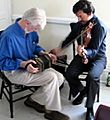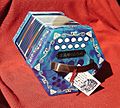Anglo concertina facts for kids
The Anglo concertina is a cool musical instrument that's part of the concertina family. It's a type of free-reed instrument, which means it makes sound when air passes over small metal reeds.
Contents
How the Anglo Concertina Started
The Anglo concertina came about by mixing ideas from two other instruments: the English and German concertinas.
Early German Concertinas
The first Anglo concertinas used button layouts similar to the 20-button German concertinas. These were designed by a person named Carl Friedrich Uhlig in 1834.
Becoming Popular
Soon after, the German concertina became very popular in places like England, Ireland, and North America. People liked it because it was easy to learn and didn't cost too much.
English Makers Join In
English instrument makers started making their own versions. They used traditional English ways of building, like special concertina reeds and separate pivots for each button. They also made them with hexagon-shaped ends.
What "Anglo-German" Means
At first, "Anglo-German" only referred to these mixed-style concertinas made in England. But later, German makers started using some of the English building methods too. So, the name "Anglo-German" began to describe any concertina that used Uhlig's 20-button system.
Playing the Anglo Concertina
The Anglo concertina has a special way of making music.
The Main Buttons
The main part of the Anglo system has two rows of 10 buttons each. These rows help you play a diatonic major scale, which is like the "do-re-mi" scale. This pattern was created around 1826 by Joseph Richter for a harmonica.
- Five buttons from each row are on one side of the instrument.
- The two main rows are musically a "fifth" apart. This means if one row plays in the key of G, the next row plays in the key of C, which is a fifth below G.
- A cool thing about Richter's tuning is that if you press three buttons next to each other in one row, you get a major chord!
Adding More Notes
Later, a third row of buttons was added. These extra buttons helped play more notes, including "accidentals" (notes not in the main scale) and notes that were already there but could be played differently. This made it easier to play more chords and melodies.
Different Layouts
The way the main buttons are set up doesn't change much between different Anglo concertinas. But the extra "helper" notes can be arranged differently. The two most common layouts for 30-button concertinas are called the Jeffries and Lachenal systems.
- You can find Anglo concertinas with 36, 38, or 40 buttons. Some even have as many as 55 keys!
- Most Anglo concertinas are in the key of C/G. Other common keys are G/D and B♭/F.
How to Hold It
You hold the Anglo concertina by putting your hands through leather straps. Your thumbs stay outside the straps, and your palms rest on wooden bars. This lets four fingers on each hand play the buttons. Your thumbs are free to use an air valve, which lets you move the bellows without making a sound.
Where It's Used
The Anglo concertina is often heard in music of Ireland. But it's also used in other types of music, like for the English Morris dance and Boeremusiek from South Africa.
Famous Players
Some famous English players of the Anglo concertina include Scan Tester, John Spiers, William Kimber, and John Kirkpatrick.
Who Makes Anglo Concertinas?
Many companies have made Anglo concertinas over the years.
Early Makers
George Jones is often seen as the first English maker of chromatic Anglo concertinas. In the late 1800s and early 1900s, other important British companies included:
- Those started by Charles Wheatstone.
- Charles Jeffries, who mostly built Anglo-style concertinas.
- Louis Lachenal, who made both English and Anglo styles and was one of the biggest makers of his time.
- John Crabb.
Images for kids







